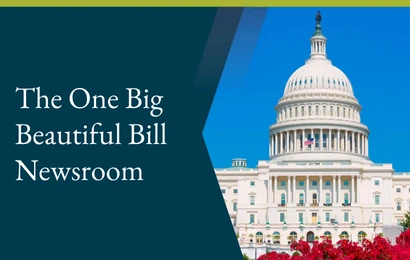Big and Beautiful SALT Implications of the Federal OBBBA
Executive Summary
The One Big Beautiful Bill Act (“OBBBA”) both extended and revised a host of federal income tax policies that apply to both individuals and businesses. Since most states (and certain localities) which impose personal income taxes (“PIT”) and corporate income taxes (“CIT”) use the federal income tax base as a starting point for calculating state taxable income, state and local jurisdictions will have to determine whether their tax codes will incorporate all or specific components of the OBBBA as codified in the Internal Revenue Code (“IRC”).
Additionally, many states will look at various OBBBA provisions from the standpoint of how adoption or modification can be utilized as a revenue-generating opportunity in the face of increased state and local governmental costs for healthcare and societal benefits based on federal changes or reductions in accordance with the OBBBA.
Detailed Overview & Observations
State & Local PIT Conformity with the IRC
Today, 41 states and Washington D.C. impose broad-based PIT, while 44 states and Washington D.C. levy a CIT. Except for New Jersey and Pennsylvania PIT tax rules, state PIT codes across the U.S. generally use federal adjusted gross income (“AGI”) computed for federal income tax purposes as the starting point for computing state taxable income. AGI is then modified with a host of different additions and subtractions as adopted via legislation or regulation in each state. These modifications can involve items like net operating loss (“NOL”) deductions, depreciation differences, tax-exempt income, and deductions available for federal income tax purposes not available for state PIT (and vice-versa).
Since AGI is a critical starting point for computing state taxable income for PIT purposes, state and local PIT codes usually elaborate on what version of the IRC should apply for computing AGI and taxable income. This determination is referred to as state and local conformity with federal rules under the IRC. Conformity with federal income tax rules can often be though about in terms of two possible regimes in the PIT world:
- Rolling conformity jurisdictions are states and localities which adopt the IRC as amended without any further legislative action, except when trying to depart from federal income tax rules. Examples of rolling conformity states include Alabama, Colorado, Connecticut, Washington D.C., Delaware, Iowa, Illinois, Kansas, Louisiana, Maryland, Missouri, Montana, North Dakota, Nebraska, New Mexico, New York, New York City, Oklahoma, Rhode Island, Utah, and Virginia.
- Static conformity jurisdictions are states and localities which fix their IRC adoptions to specific dates and will require legislation to adopt more recent changes. Examples of static conformity states are Arizona, California, Georgia, Hawaii, Idaho, Indiana, Kentucky, Maine, Michigan, Minnesota, North Carolina, Ohio, Oregon, South Carolina, Vermont, and Wisconsin.
Despite the conformity statute in effect for PIT purposes, there are some areas where states have proactively decoupled from certain IRC provisions applied for computing federal AGI or taxable income such as the pass-through business income deduction under IRC 199A, bonus depreciation, IRC 179 business expensing, and NOL carryforward and carryback rules.
State & Local CIT Conformity with the IRC
Similarly, state CIT codes begin the tax base computation by reference to the federal corporate income tax base. Approximately 22 states use taxable income before NOL deduction and special deductions as reported on Line 28 of IRS Form-1120 (Corporate Income Tax Return) as the starting point for computing the state tax base. About twenty states use taxable income after NOL deduction and special deductions as reported on Line 30 of IRS Form-1120 as their starting point for computing the CIT base. Since the federal corporate income tax base is the starting point in state and local CIT rules, IRC conformity is just as relevant for CIT purposes as it is for state and local PIT purposes.
- Rolling conformity jurisdictions which adopt the IRC as amended include Alaska, Alabama, Colorado, Connecticut, Washington D.C., Delaware, Iowa, Illinois, Kansas, Louisiana, Massachusetts, Maryland, Missouri, Montana, North Dakota, Nebraska, New Jersey, New Mexico, New York, Oklahoma, Philadelphia (Business Income & Receipts Tax) Rhode Island, Tennessee, Utah, and Virginia.
- Static conformity jurisdictions which adopt specific or prior versions of the IRC include Arizona, California, Florida, Georgia, Hawaii, Idaho, Indiana, Kentucky, Maine, Minnesota, North Carolina, New Hampshire, South Carolina, Texas (Franchise Tax), Vermont, and Wisconsin.
Again, many jurisdictions have decoupled from specific provisions of the IRC. For instance, more than 25 states do not conform with federal bonus depreciation. In addition, states like Georgia, Indiana, New Jersey, and Wisconsin passed legislation to proactively depart from federal rules amortizing IRC 174 expenditures under the Tax Cuts and Jobs Act of 2017 (“TCJA”).
Another significant area for consideration in the realm of state and local conformity is that of federal Opportunity Zones (“OZ”). The revised OZ provisions under IRC 1400Z-2 include a fixed 5-year deferral for recognizing capital gains invested in Qualified Opportunity Funds (“QOF”) that in turn invest directly or indirectly in real estate and businesses based in OZs. Investors that hold these QOF investments for 10 years or more can receive a tax basis step-up to fair market value when selling their interests or the QOF directly or indirectly sells a qualifying asset.
Prior to enactment of the OBBBA, most states conformed with the OZ deferral and basis step-up provisions except for California, which bases its income tax code on the IRC as of January 1, 2015, and a few other states which proactively adopted legislation or guidance which decoupled, such as North Carolina, New York, and Washington State (for capital gains tax purposes). Due to state revenue concerns stemming from the OBBBA, there may be more of an appetite for states to decouple than in prior tax years. Conversely, due to the OBBBAs increased reporting requirements for QOF investments and more stringent qualifications for the selection of OZs throughout the country, perhaps the nonconforming states will decide to change course.
Due to the tax policy changes and extensions to various provisions of the IRC that comprise the OBBBA, state and local taxing authorities and legislatures which have historically been rolling conformity jurisdictions for PIT and CIT purposes may have to rethink those policy decisions. Similarly, state legislatures and taxing authorities in static conformity states and localities will need to decide whether there may be provisions of the OBBBA they would like to proactively incorporate into their respective PIT and CIT codes.
Elective Pass-Through Entity Taxes
The TCJA imposed a $10,000 cap on the state and local tax (“SALT”) deduction available to individual taxpayers. The $10,000 SALT cap negatively impacted taxpayers in states which impose property taxes on real estate in addition to broad-based PIT. Accordingly, to provide tax relief to pass-through entity (“PTE”) business owners, 36 states adopted elective PTE taxes which allows an eligible PTE to make an election to pay state income tax at the entity level. The owners of an electing PTE either receive a state tax credit for the amount of PTE tax paid on their share of the entity’s income applied against the respective state’s PIT or there is an exclusion for income that is subject to elective PTE tax when computing taxable income for PIT purposes.
Since state income taxes imposed on and paid by the PTE are deductible at the entity level for federal income tax purposes, there is no cap on the amount deducted by an electing PTE. In the fall of 2020, the Internal Revenue Service (“IRS”) issued Notice No. 2020-75, which indicated that the IRS would treat these elective state taxes as fully deductible at the PTE level with no stated limitations or restrictions.
While state elective PTE tax was the subject of much debate and conversation when the OBBBA was being considered and amended, there was no change made to the IRC that would limit or prohibit entity-level deductions for elective PTE taxes paid. Additionally, the OBBBA increases the federal SALT cap to $40,000 with an income phase-out beginning at AGI of $500,000.
Therefore, elective PTE taxes remain a viable and attractive tax savings tool for ordinary PTE income in high tax states or localities; and even more so for PTE owners that are contemplating selling their businesses soon. That being said, we may see a few changes to these taxes. One simple modification involves extending the PTE tax in states that tied their PTE tax regimes to specific tax periods, such as: Illinois, Oregon, Utah, and Virginia.
Due to the increase in the SALT cap and income phase-out, many states will likely amend their PTE tax codes to permit individual owners (partners/shareholders) to opt in or out of the tax when an election is made by the entity, similar to how California affords taxpayers this option under current law. Another potential change that states may adopt to generate revenue is reducing the amount of the PTE tax credit or income exemption available to electing PTE owners for PIT purposes. Currently, Connecticut and Massachusetts do not provide a full 100 percent credit for the total PTE tax paid on an owner’s share of income by an electing entity.
Net CFC Tested Income as the New GILTI
Under the TCJA, U.S. shareholders of controlled foreign corporations (“CFC”) must report most active business income of a CFC as an income inclusion referred to as global intangible low-taxed income (“GILTI) pursuant to IRC 951A. GILTI is currently computed by reducing the income inclusion by the “net deemed tangible income return” (“NDTIR”) which is usually 10% of the shareholder’s allocable share of the CFC’s depreciable trade or assets. In addition, there is a deduction provided under IRC 250 for 50 percent of the GILTI inclusion.
For PIT purposes, a resident of any state which is a rolling IRC conformity jurisdiction pays tax on GILTI except for taxpayers residing in Hawaii, Kansas, South Carolina, and Wisconsin — all states which proactively decoupled from the federal GILTI regime. For nonresident states, since GILTI is akin to dividends and other forms of intangible income, only the state of residence may impose tax on this income for PIT purposes. In the event a state took a different view, the income is earned through activities, operations and property based in a foreign nation; therefore, no state could claim GILTI as being derived from sources in the taxing state.
Despite these PIT rules, if the GILTI flows through a PTE before being allocated to the PTE’s owners, the income may be included in income subject to apportionment for a nonresident owner in a state where the PTE conducts business. Similarly, a corporation subject to state CIT may face a similar issue in terms of whether the GILTI gets apportioned to all taxing jurisdictions where the corporation conducts business. However, in the corporate context, many states have proactively enacted various subtractions from income for GILTI or have opted to treat GILTI as a dividend eligible for the state’s dividends-received deduction (“DRD”). Approximately 9 states treat GILTI as a dividend income for purposes of eligibility for a DRD, while approximately 13 states either completely decoupled or provide for a full or partial exclusion for GILTI.
When it comes to PTE and CIT apportionment, if GILTI is included in net income subject to apportionment, there have been two methodologies that states and localities have adopted. The first approach involves including GILTI in the receipts factor denominator, but not in the numerator. This has the mathematical impact of causing a large amount of GILTI to not be subject to the state’s applicable marginal CIT rate or PIT rate for a PTE owner. The other approach adopted by other taxing jurisdictions involves excluding the GILTI inclusion from the receipts factor entirely, including both the numerator and denominator. This method has the mathematical impact of causing the GILTI to be subject to tax in the taxing state by reference to the business entity’s apportionment factor.
Effective for tax year 2026, the OBBBA makes a series of technical changes to this deemed income inclusion regime, including now referring to this income as net CFC-tested income (“NCTI”), eliminating the NDTIR component of the calculation, and reducing the IRC 250 deduction to 40 percent of the GILTI inclusion. These technical tax changes taken together with the premise that states do not provide a credit for foreign taxes paid mean there will likely be increased NCTI income inclusions that could potentially make their way into the state CIT or PIT base.
To generate additional revenue, states and localities that opted to treat GILTI as dividend income eligible for a DRD may be inclined to depart from this favorable classification and include NCTI in net income subject to apportionment for CIT purposes. Similarly, states and localities that enacted specific subtractions or exclusions for GILTI for CIT and PIT purposes, may reduce those exclusions or deductions in the context of NCTI.
Additionally, since NCTI may be included in apportionable income for PIT and CIT purposes, states may opt to either (1) exclude the NCTI from the receipts factor altogether; (2) include a portion of the NCTI in the sales factor numerator based on population or market data; (3) include all NCTI in the sales factor numerator for businesses domiciled in the state; or (4) throw out the NCTI from the sales factor denominator when the NCTI cannot be sourced to any jurisdiction using that state’s receipts sourcing rules.
All the NCTI receipts factor options above can increase taxable income and therefore generate significant new revenues for adopting states and localities. These options will be the subject of future debates in state and city capitals.
174 Research and Experimental Expenses
For tax years 2022 – 2024, the TCJA required that instead of being immediately deductible, research and experimental (“R&E”) expenditures must be amortized over 5 years for domestic R&E activities and 15 years for foreign R&E activities. A static conformity state like California automatically did not conform with this change, while other states proactively decoupled to allow for immediate deductions for R&E activities, such as Georgia, Indiana, New Jersey, and Wisconsin.
The OBBBA reinstated the ability to immediately deduct domestic R&E expenditures pursuant to new IRC section 174A. The federal legislation also provides for the retroactive application of IRC Section 174A by filing amended returns for certain eligible small businesses as defined under the OBBBA.
Since most states conformed with IRC 174 changes under the TCJA, states are also expected to conform with new IRC 174A unless there is a reason for a state to accelerate revenues by requiring amortization of R&E expenses. Regarding the ability to apply IRC 174A on amended returns for small businesses, state conformity may be a more complicated analysis.
As a threshold matter, most state PIT and CIT codes mandate that when federal amended returns are filed (or changes are made via audit), state amended returns (or explanation of federal changes) must be filed with the state taxing authority as well. For a multi-state business, this could represent an additional compliance cost. Furthermore, the additional and accelerated deductions from R&E expenses may not be as beneficial to a taxpayer in a state where apportionment is low or was lower than in the current period, there are other significant subtractions to the state tax base, or a state NOL carry forward is available. Another complicating factor is whether state tax credits or NOLs were claimed on the original state CIT or PTE filing and those credits and NOLs have no further carry forward periods.
Finally, if dealing with a PTE and it made a state election to report and pay entity-level PTE tax, the accelerated deductions from R&E expenses under IRC 174A will reduce state taxable income and generate state overpayments. These overpayments arguably need to be included in federal AGI when calculating federal taxable income — thereby reducing the net benefit associated with amending returns for immediate R&E deductions.
Early State Reactions to the OBBBA
As expected, states have already started to evaluate the impacts of the OBBBA from a revenue, operations, and tax policy perspective. The Office of State Planning and Budgeting within the Governor’s office of Colorado issued a report that indicates Colorado faces revenue losses that will exceed $1 billion from the OBBBA due to the state’s rolling IRC conformity. Similarly, the Pennsylvania Independent Fiscal Office issued a “budget brief” which provides that OBBBA provisions will increase the state’s projected deficit unless Pennsylvania decouples for CIT purposes. A report issued by the Connecticut Comptroller’s Office also points to some expected state revenue losses stemming from the OBBBA. And finally, Governor Murphy of New Jersey issued an executive order for a study to be undertaken on the OBBBA’s impact on state revenue and operations with recommended administrative and legislative policy changes in response.
As state legislatures return to active sessions from the summer, there will be more revenue reports and studies issued to justify making tax policy changes due to projected revenue shortfalls caused by tax provisions of the OBBBA. Businesses and their advisors will need to be mindful of these policy discussions and future changes as states and localities craft their responses to the federal changes.
How Citrin Cooperman Can Help
Citrin Cooperman’s National Tax Office is actively monitoring developments on the federal side in addition to state and local responses. Please reach out to Jaime Reichardt or another member of our State and Local Tax Practice should you have any questions or would like to discuss the contents of this article.
Explore the Latest OBBBA Updates

Latest Article Cards

Uncharted No More: Fees and Carried Interest in the Independent Sponsor Sector
Read More

Improving Customer Experiences: The Case for Migrating to Azure
Read More

Shades of Grey: Disclosures Under Section 6103(e)(8)
Read More

Cannabis Industry Alert: Executive Order Directs Completion of Marijuana Rescheduling Rulemaking
Read More


